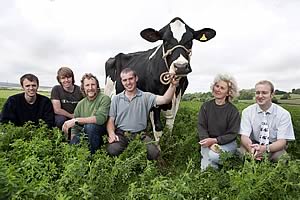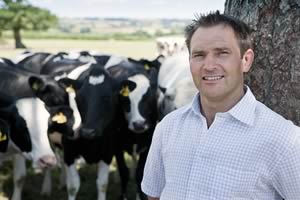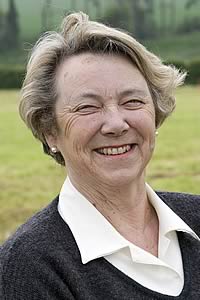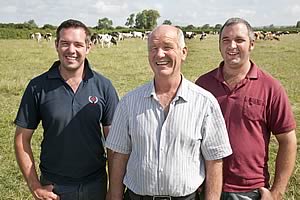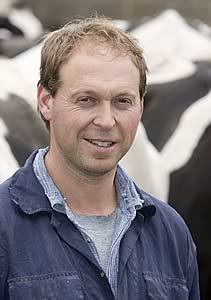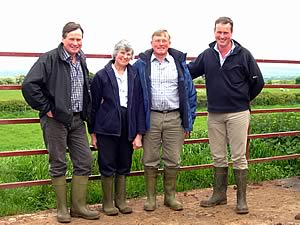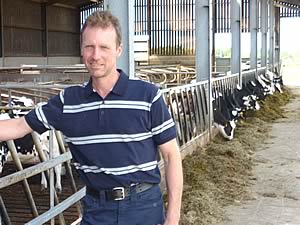 |
|||||||||
|
||||||||||||||||||||||||
|
|
Eight Go for Gold in Dairy Industry’s Top Award NMR and RABDF have named eight dairy businesses out of 1,000 qualifying herds as finalists in this year’s Gold Cup. The eight, including five from the south west and one each from Gloucestershire, Shropshire and Lancashire, have been visited by a team of judges and the winner will be announced at the Dairy Event, at the NEC on Tuesday September 7. The Eight NMR/RABDF Gold Cup finalists are: King Family, Vortex Holsteins Ltd, Church Farm, Martinstown, Dorchester, Dorset
The King family sell more than two million litres of milk each year to Dairy Crest on a Sainsbury’s dairy Development Group (SDDG) liquid contract from their Vortex herd of pedigree Holsteins. Tom King is the fourth generation at Church Farm and runs the 120-hectare unit with his father Alan. During the past 10 years cow numbers have doubled to the current 260 cows and they have invested in new cow housing and a larger slurry store. For the year ending September 2009, average yield was 11,386kg at 3.95% fat and 2.95% protein with a calving interval of 403 days and an average cell count of 81,000/ml.
Neil Baker runs an 830-cow herd on a 600-hectare unit, producing more than eight million litres of milk a year, a third of which is used in the production of 270 tonnes of vintage cheddar sold through three supermarket chains – M&S, Waitrose and Tesco – under their own vintage cheddar brands. This takes a staff of 17 plus Neil and includes two herd managers who look after the milking and herd health respectively. They both work very closely with the herd’s two vets, keeping to a comprehensive herd health regime. Milk production for the Gold Cup qualifying year for this herd was 10,420kg of milk, at 3.99% butterfat and 3.26% protein on three-times-a-day milking, with a 396-day calving interval.
Organically farmed since 2007, the Lakemead Friesian herd of 400 cows and 360 young stock, including beef-cross animals, is split across two units with a separate young stock rearing unit. Heifers are allocated back to meet either unit’s requirement so there’s no favouritism with genetics. The herd has been closed for two decades with all replacements home bred. The breeding policy has played a very large part in the herd’s success – Mary aims to breed farmer friendly cows that are sustainable and have a good balance of production, strong feet and good fertility. Average production for the year ending September 2009 was 7,764kg at 4.08% fat and 3.32% protein with an average cell count of 136,000/ml. The calving interval is 385 days. Milk is sold to Yeo Valley.
Barry Coombes, Blackford, Wedmore, Somerset Since moving to New Grove Farm seven years ago Barry Coombes and his sons Jack and Sam have reseeded nearly all the grassland and installed a new milking parlour. At the same time they have doubled cow numbers to the current 195 Holstein cows plus Barry’s 12 Ayrshires. While Barry concentrates on the herd’s breeding and milking duties, Jack rears all the calves and Sam concentrates on the field work. Nearly half the milk comes from forage so there is great emphasis on producing high quality forage. Plans are afoot to increase cubicle housing by 50% so they can group cows better and improve dry cow facilities. For the year ending September 2009 the herd averaged 10,700kg at 4.03% fat and 3.07% protein with an average somatic cell count of 110,000/ml and a calving interval of 408 days.
The King brothers have made significant changes in the past 20 years at Two Pools Farm, reinstating the dairy herd in 1990 and expanding it from 47 cows on 49 hectares to its current 560 Holsteins – with 314 cows in the milking herd – and a total of 405 hectares including 182 hectares of arable crops. Around £98k has recently been invested in improved housing and new slurry handling facilities. Milk is sold to Farmright and they are very involved in producing milk for its niche markets. The successful day-to-day running of the dairy is credited to manager Martyn Smith and his team who achieve exceptional levels of health and welfare resulting in a replacement rate of only 11%. Average production is 9,843kg of milk at 3.85% fat and 3.15% protein on twice-a-day milking with an average cell count of 184,000/ml.
Despite herd expansion and diversification into retailing, cow health and welfare remain the priority for Chris Simmons and his father Lionel and their team. Chris believes milking three times a day is key to the herd’s health. He also keeps the system simple and invests in staff training to ensure they all work to the same protocols. Milked three times a day and calving all year round, the 282 Holstein cows averaged 11,446kg of milk at 3.7%fat and 3.27% protein for the Gold Cup qualifying year with a cell count average of 185,000/ml and a 403-day calving interval. The milk is sold to Lucy’s Dairy – a company run by Chris’ wife Lucy and supplying milk and cream to local outlets and doorstep deliveries, or to Farmright on a premium liquid contract.
The philosophy of ‘look after the cows and the cows will look after you’ is the driver behind the success of the pedigree Wilderley herd, which after more than 15 years of natural expansion, is top of NMR’s national production league. Bill and Margaret Higgins took on the 80-hectare Wilderley Hall Farm, near Shrewsbury, in 1965. The farm is now 145 hectares with 245 Holstein cows and followers. Growth in herd size has been organic and the herd has been closed for the past 40 years. Run now with sons Andrew and Bill, they operate a high-input system and cows are housed and calve all year round. This maximises the use of the buildings and labour. The Wilderley herd averaged 12,444kg of milk at 3.72% fat and 3.08% protein on three-times-a-day milking for the year ending September 2009. More than 2.75 million litres were sold to Wiseman on a Tesco contract during the year ended March 2010.
James Burrow and his wife Krisha have built up the 215 Holstein cow Stardale herd since taking over the 115-hectare tenancy with 20 cows in 2006. The herd is run on a traditional summer grazing system, with all the cows turned out in April and re-housed at the end of October, weather permitting. Simplicity is one of the vital ingredients for success of this unit that is run by James, his full-time herdsman Matt Green and father Bob. The aim is to maintain healthy, trouble-free cows so that most, if not all, achieve lifetime yields of at least 50,000 litres. Milk is sold to Tesco, via Arla. Production for the Gold Cup qualifying year was 9,786kg of milk at 4.09% butterfat and 3.28% protein, with a 389-day calving interval.
All eight finalists have been visited by this year’s judges: David Cotton, Chairman RABDF, Philip Kirkham, Chairman NMR and Ian Macalpine, 2007 Gold Cup winner. The 2010 Gold Cup winner and runner up will be announced at the Dairy Event on Tuesday September 7, NMR stand, BM 226 in the Business Management Zone, 4.30pm. The Chris May Memorial Salver will also be awarded to the Gold Cup qualifying herd with the highest average lifetime daily yield.
|
|||||||||||||||||||||||

|
|
|||||||||||||||||||||||
| home | agri-services | pedigree
pen | news | dairy | beef | machinery property | organisations | site map |
||||||||||||||||||||||||
